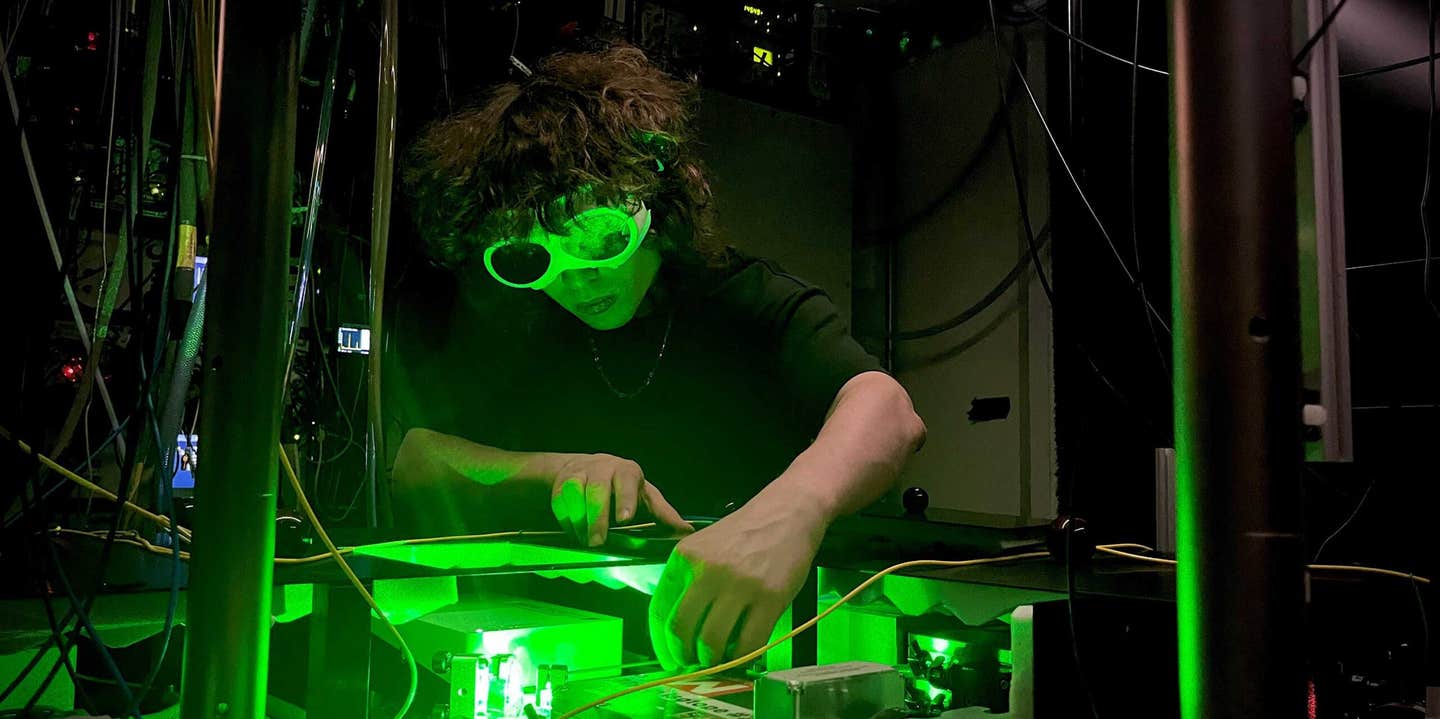Swiss physicists detect traces of a potential fifth force of nature
ETH Zurich researchers use calcium isotope measurements to probe for a potential fifth force beyond the Standard Model.

Luca Huber, doctoral student at ETH Zurich, aligns a laser light for an experiment with calcium isotopes. (CREDIT: Gabriele Giuli / ETH Zurich)
Physicists in Switzerland are turning to a new method in the search for nature’s possible fifth force—one that might explain some of the universe’s greatest mysteries. Their work centers on atomic spectroscopy, a technique that allows them to measure tiny shifts in the energy levels of atoms with incredible precision. These subtle changes could point to an undiscovered particle responsible for a new force acting between electrons and neutrons.
The research, led by a team at ETH Zurich, aims to find evidence of a force beyond the four known ones: gravity, electromagnetism, and the strong and weak nuclear forces. While past searches have relied heavily on particle accelerators like the Large Hadron Collider, this team is exploring a more delicate route. By examining how electrons behave in calcium isotopes, they hope to find the fingerprints of something new—a clue that might extend the boundaries of modern physics.
Searching Beyond the Standard Model
The Standard Model of particle physics has helped scientists map out the structure of matter and the forces that govern it. But even with its success, the model cannot explain everything. One of the biggest gaps is dark matter, the mysterious substance that makes up most of the universe’s mass.
Though invisible, dark matter reveals itself through the way galaxies rotate and how gravity behaves on large scales. Physicists suspect that dark matter may require a new theory—possibly involving a fifth fundamental force.
Diana Prado Lopes Aude Craik, a physics professor at ETH Zurich, has long studied this possibility. “The Standard Model is currently the best explanation of the universe,” she said. “But we know it cannot explain everything.” She and her team think an unknown force might connect the neutrons in an atom’s nucleus to the electrons orbiting around it. This hypothetical interaction could be carried by a new particle, much like how photons carry the electromagnetic force.
Instead of smashing particles together at high speeds, Craik’s team is using atomic physics to look for tiny clues that might suggest this new force exists. “As atomic physicists, we can measure the atom with extremely high precision,” she said. Their approach involves comparing different versions of the same atom, known as isotopes, and measuring the way their energy levels shift.
Related Stories
- Rare 'Einstein zig-zag' sheds light on universe’s hidden forces
- Groundbreaking Qudits simulate complex interactions between matter and force fields
- Black hole pairs reveal hidden new forces and unseen particles
Probing Calcium Atoms for Clues
Isotopes are atoms with the same number of protons and electrons, but different numbers of neutrons. These slight differences in mass can affect how electrons experience forces within the atom. If a new force exists, it could slightly alter the energy levels of electrons in atoms with more or fewer neutrons.
To explore this, the team studied five stable isotopes of calcium. Each atom had 20 protons, but their neutron counts ranged from 20 to 28. The scientists used a precision instrument called an ion trap, where electromagnetic fields hold a single charged atom in place. Then, they excited the atom with lasers and recorded the light it emitted during changes in energy levels.
They achieved a remarkable level of precision—measuring shifts as small as 100 millihertz, which is 100 times more precise than past measurements. One key to their success was trapping two isotopes at once, allowing for side-by-side comparisons while reducing noise that could interfere with the results.
Testing Limits with International Help
Despite this high accuracy, the team wanted to rule out other known effects that might cause similar energy shifts. Collaborators in Germany and Australia joined the effort. A group at the Physikalisch-Technische Bundesanstalt in Braunschweig tested the same calcium isotopes in a more highly charged state. Meanwhile, another team at the Max Planck Institute for Nuclear Physics in Heidelberg measured the ratios of nuclear masses between the isotopes with unmatched accuracy.
After analyzing all the data, the results showed something unexpected. The small differences in energy levels couldn’t be fully explained by known nuclear effects alone. One potential explanation was nuclear polarization—a rare and poorly understood behavior where the nucleus slightly deforms due to interactions with electrons. The calculations suggested that this effect might be large enough to account for the data, although it could still fit within the current Standard Model.
“We can’t say that we’ve discovered new physics here,” Craik admitted. “However, we know how strong the new force can be at most because we would have seen it otherwise in our measurements, even with the uncertainties.”
Still, the researchers used the data to place new limits on the possible mass and electric charge of a hypothetical particle that might carry this fifth force. These boundaries help refine the search and point future studies in a more focused direction.
What Comes Next
The team’s work isn’t finished. They are currently measuring a third energy transition in the calcium isotopes. With even greater precision, this new data will help them build a three-dimensional version of what’s called the King plot. This tool helps physicists visualize how energy levels in isotopes shift and whether those shifts follow known laws—or hint at something new.
“We hope that this will help us overcome the theoretical challenges,” said Craik, “and make further progress in the search for this new force.”
Their research, titled “Nonlinear Calcium King Plot Constrains New Bosons and Nuclear Properties”, was published in Physical Review Letters. It marks a major milestone in the growing field of high-precision atomic spectroscopy as a tool for exploring the unknown.
This effort to detect a fifth force using careful measurements, rather than massive machines, offers a fresh way to explore the universe’s hidden structure. It could someday help explain dark matter, challenge current physics theories, and lead to discoveries that reshape our understanding of the cosmos.
Note: The article above provided above by The Brighter Side of News.
Like these kind of feel good stories? Get The Brighter Side of News' newsletter.



